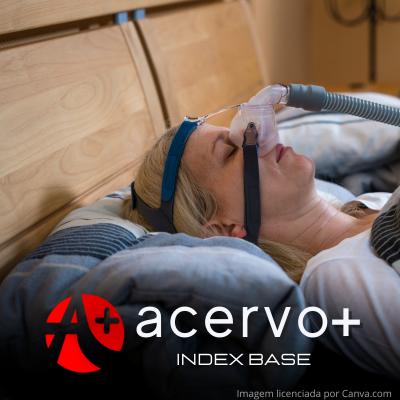Correlação entre a gravidade da síndrome de apneia hipopneia obstrutiva do sono em mulheres pós menopausa e obesas
##plugins.themes.bootstrap3.article.main##
Resumo
Objetivo: Investigar a relação entre a síndrome de apneia hipopneia obstrutiva do sono (SAHOS), obesidade e marcadores de estresse oxidativo em mulheres obesas pós-menopausa. Métodos: Participaram deste estudo experimental um total de 28 pacientes do sexo feminino. As pacientes foram divididas em três grupos de acordo com sua classificação no Índice de Apneia/Hipopneia (IAH): G1 (11 indivíduos) com IAH ≤ 5 e IMC ≥ 29,9 kg/m2; G2 (9 indivíduos) com 5 ≥ IAH ≤ 15 e IMC ≥ 29,9 kg/m2; G3 (8 indivíduos) com IAH ≥ 15 e IMC ≥ 29,9 kg/m2. Foram avaliadas a produção de superóxido, nitritos e nitratos séricos nessas pacientes, correlacionando-os com o IAH. Resultados: Não foram observadas diferenças significativas entre os grupos em relação à produção dos marcadores de estresse oxidativo. Além disso, não foram encontradas correlações significativas entre a produção de superóxido e nitritos/nitratos séricos e o índice de apneia hipopneia (IAH) (r = 0,161; p = 0,074 e r = -0,357; p = 0,385, respectivamente). Conclusão: Em mulheres obesas pós-menopausa, não há correlação entre a gravidade da síndrome de apneia hipopneia obstrutiva do sono e os marcadores de estresse oxidativo avaliados.
##plugins.themes.bootstrap3.article.details##
Copyright © | Todos os direitos reservados.
A revista detém os direitos autorais exclusivos de publicação deste artigo nos termos da lei 9610/98.
Reprodução parcial
É livre o uso de partes do texto, figuras e questionário do artigo, sendo obrigatória a citação dos autores e revista.
Reprodução total
É expressamente proibida, devendo ser autorizada pela revista.
Referências
2. ALZOGHAIBI MA e BAHAMMAM AS. Lipid peroxides, superoxide dismutase and circulating IL-8 and GCP-2 in patients with severe obstructive sleep apnea: a pilot study. Sleep and Bre, 2005; 9(3):119-26.
3. ARNAUD C, et al. Obstructive sleep apnoea and cardiovascular consequences: pathophysiological mechanisms. Archives of Cardiovascular Diseases, 2020; 113(5): 350-358.
4. BARCELÓ A, et al. Antioxidant status in patients with sleep apnoea and impact of continuous positive airway pressure treatment. European Respiratory Journal, 2006; 27(4):756–760.
5. DE SOUZA FS, et al. Síndrome da apneia e hipopneia obstrutiva do sono e principais comorbidades associadas. Revista de Ciências Médicas, 2020; 29: 1-9.
6. FIETZE I, et al. Prevalence and association analysis of obstructive sleep apnea with gender and age differences–Results of SHIP‐Trend. Journal of Sleep Research, 2019; 28(5): e12770.
7. GALLEGARIO TRS, et al. A influência do estresse e da obesidade na infertilidade feminina e sua análise evolutiva: uma visão integrativa The influence of stress and obesity on female infertility and its evolutionary analysis: an integrative vision. Brazilian Journal of Development, 2021; 7(10): 99637-99656.
8. GRASEMANN H e HOLGUIN F. Oxidative stress and obesity-related asthma. Paediatric Respiratory Reviews, 2021; 37: 18-21.
9. HARADA Y, et al. Differences in Associations between Visceral Fat Accumulation and Obstructive Sleep Apnea by Sex. American Thoracic Society, 2014: 28.
10. IANNELLA G, et al. Obstructive Sleep Apnea Syndrome: From Symptoms to Treatment. International. Journal of Environmental Research and Public Health, 2022; 19(4): 2459.
11. JAKUBIAK GK, et al. Oxidative stress in association with metabolic health and obesity in young adults. Oxidative. Medicine and Cellular Longevity, 2021; 2021: 1-19.
12. LEE JJ e SUNDAR KM. Evaluation and management of adults with obstructive sleep apnea syndrome. Lung, 2021; 199(2): 87-101.
13. LESSA RT, et al. A privação do sono e suas implicações na saúde humana: uma revisão sistemática da literatura. Revista Eletrônica Acervo Saúde, 2020; (56): e3846.
14. LIRA AB. Avaliação do estresse oxidativo na síndrome da apneia obstrutiva do sono e utilização de terapia oxidante. Tese (Doutorado em Ciências da Saúde) – Instituto de Ciências Biológicas e da Saúde. Universidade Federal de Alagoas, Maceió, 2020; 71 p.
15. MA XR, et al. Imbalance of osteoprotegerin/receptor activator of nuclear factor-κB ligand and oxidative stress in patients with obstructive sleep apnea-hypopnea syndrome. Chinese Medical Journal, 2019; 132(01): 25-29.
16. MALHOTRA A, et al. Metrics of sleep apnea severity: beyond the apnea-hypopnea index. Sleep, 2021; 44(7): zsab030.
17. MANIACI A, et al. Oxidative stress and inflammation biomarker expression in obstructive sleep apnea patients. Journal of Clinical Medicine, 2021; 10(2): 277.
18. MELIANTE PG, et al. Molecular Pathology, Oxidative Stress, and Biomarkers in Obstructive Sleep Apnea. International Journal of Molecular Sciences, 2023; 24(6): 5478.
19. NG SS, et al. Validation of Embletta portable diagnostic system for identifying patients with suspected obstructive sleep apnoea syndrome (OSAS). Respirology, 2010; 15(2): 336-42.
20. PERES BU, et al. Obstructive sleep apnea and circulating biomarkers of oxidative stress: a cross-sectional study. Antioxidants, 2020; 9(6): 476.
21. RAMANATHAN L, et al. Sleep deprivation decreases superoxide dismutase activity in rat hippocampus and brainstem. Neuroreport, 2002; 13:1387–1390.
22. SEQUEIRA AR. Biomarcadores de disfunção tubular em doenças cardiometabólicas. Dissertação (Mestrado em Tecnologias Clínico-Laboratoriais) - Escola Superior de Tecnologia da Saúde de Lisboa. Instituto Politécnico de Lisboa, Lisboa, 2022; 69 p.
23. SIMIAKAKIS M, et al. Lack of Effect of Sleep Apnea on Oxidative Stress in Obstructive Sleep Apnea Syndrome (OSAS) Patients. PLoS ONE, 2012; 7(6): e39172.
24. SIMPSON L, et al. Sex differences in the association of regional fat distribution with the severity of obstructive sleep apnea. Sleep, 2010; 33(4): 467-74.
25. SVATIKOVA A, et al. Oxidative stress in obstructive sleep apnoea. European Heart Journal, 2005; 26: 2435–2439.
26. WON CH, et al. Varying hypopnea definitions affect obstructive sleep apnea severity classification and association with cardiovascular disease. Journal of Clinical Sleep Medicine, 2018; 14(12): 1987-1994.

